Owls
Owls are a good match for bats since they’re both nocturnal hunters. You may have seen an owl out and about during the day, but that’s typically a rare occurrence. Owls prefer the nightlife, and due to their incredible eyesight, they have the ability to take out bats hunting in the same area as them.
Bats use sound to hunt, yet despite their keener senses, they occasionally can't avoid an owl. Although they are not a common food source for owls, bats do exist. Because bats are more difficult to catch than rodents, owls are less prone to hunt them. First of all, even though owls are adept flyers, it's still more difficult to catch something in the air than it is on the ground since bats can fly. Bats are also capable of giving their all. They are able to echo locate, which entails that they can send out calls to the environment and listen for the echoes that adjacent objects return to those calls. By doing this, they can identify where objects are and locate them in their spatial navigation so they can efficiently hunt and stay safe while flying. This means that although owls can utilise their amazing silent flight to catch unsuspecting rodents, this doesn’t work for bats because they can detect an owl’s presence purely by echolocation.
Bats aren't likely to be on the ground because owls rather prefer to hunt from above where they can readily use their talons to attack their prey. They are either hanging on something, flying, or pressing up against a tree. Bats can even follow close behind an owl until the owl stops looking for them, at which point the bat will fly away safely after the owl stops looking for them. Bats are more likely to fight back if they are assaulted mid-flight. So yes, owls do hunt bats, and they are responsible for about 11% of annual bat mortality. A bat is often a reliable source of prey for many owl species, though this might vary depending on the species of bat and the environment.







